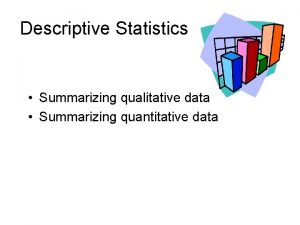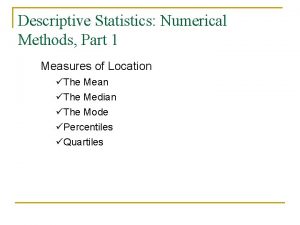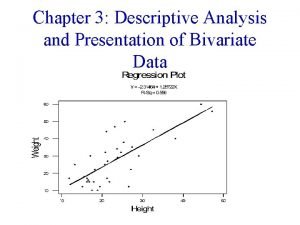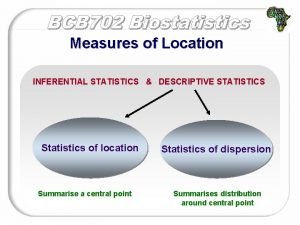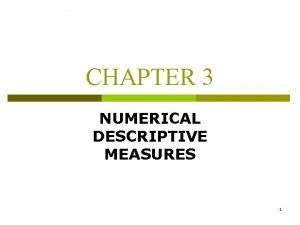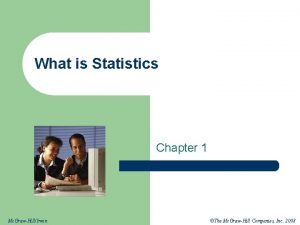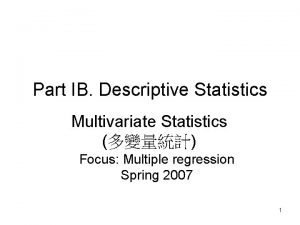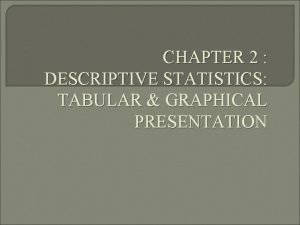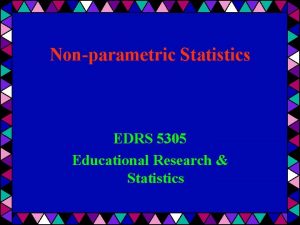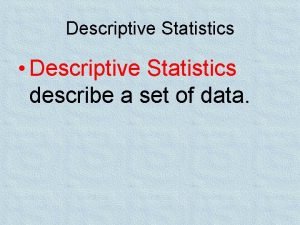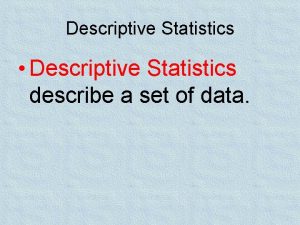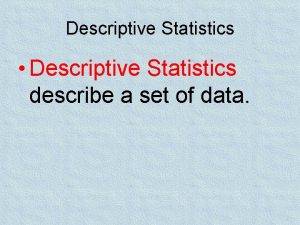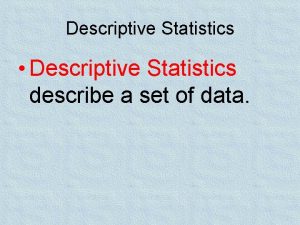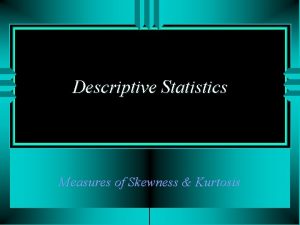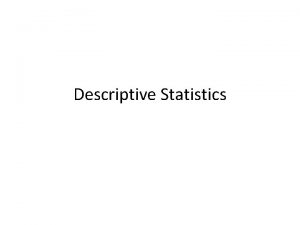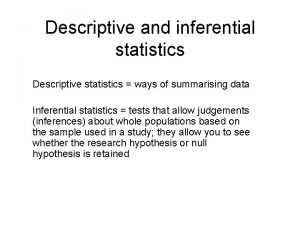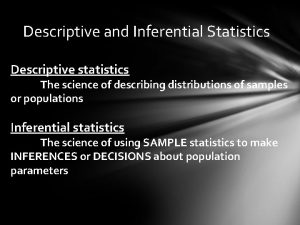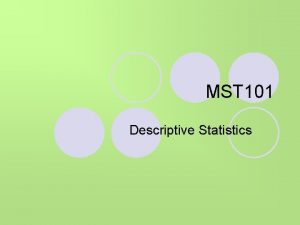Chapter 2 EDRS 5305 Fall 2005 Descriptive Statistics

































- Slides: 33

Chapter 2 EDRS 5305 Fall 2005

Descriptive Statistics § Organize data into some comprehensible form so that any pattern in the data can be easily seen and communicated to others

Frequency Distribution § An organized tabulation of the number of individual scores located in each category on the scale of measurement.

Frequency Distritbutions (cont. ) § Organizes data § From highest to lowest § Grouping § Allows the researcher to see “at a glance” all of the data § Allows the researcher to see a score relative to all the other scores § By adding the frequencies, you can determine the number of scores or individuals

Example 2. 1 N=20 8, 9, 8, 7, 10, 9, 6, 4, 9, 8, 7, 8, 10, 9, 8, 6, 9, 7, 8, 8

X f 10 2 9 5 8 7 7 3 6 2 5 0 4 1 Ef=N Ef=20 EX=158 EX 2=1288

Proportions and Percentages § There are other measures that describe the distribution of scores that can be incorporated into the table § Proportion § Percentage

Proportion § Measures the fraction of the total group that is associated with each score § Example 2. 1 § 2 out of the 20 individuals scored a 6 § Proportion § 2/20 = 0. 10 § Proportion = p = f/N

Proportions (cont. ) § Proportions are called relative frequencies § Because they describe the frequency (f) in relation to the total number (N)

Percentages § Distribution can also be described as percentages § Example 15% of the class earned an A § To compute: § Find the proportion (p) § Multiply by 100 § Percentage = p(100) = f (100) N

p=f/N %=p(100) X f 10 2 2/20 = 0. 10 10% 9 5 5/20 = 0. 25 25% 8 7 7/20 = 0. 35 35% 7 3 3/20 = 0. 15 15% 6 2 2/20 = 0. 10 10% 5 0 0/20 = 0 0% 4 1 1/20 = 0. 05 5%

Grouped Frequency Distribution Table § Can show groups of scores instead of each score individually § Example 90 -100 5 scores § These groups or intervals are called class intervals

Guidelines for Grouped Frequency Distribution Tables § Should have about 10 class intervals § Width of each interval should be a relatively simple number § Count by 10 s or 5 s, etc. § Each class interval should start with a score that is a multiple of the width § 10, 20, 30, etc. § All intervals should be the same width

Example 2. 3 82, 58, 64, 80, 75, 72, 87, 73, 88, 94, 84, 78, 93, 53, 84, 87, 69, 84, 61, 91, 70, 76, 89, 75, 60

Steps § Determine range of scores § X=53 lowest § X=94 highest


Copyright © 2002 Wadsworth Group. Wadsworth is an imprint of the Wadsworth Group, a division of Thomson Learning Table 2. 1 A grouped frequency distribution table

Histograms § A picture of the frequency distribution graph § A vertical bar is drawn above each score § The height of the bar corresponds to the frequency § The width of the bar extends to the real limits of the score § A histogram is used when the data are measured on an interval or a ratio scale


Copyright © 2002 Wadsworth Group. Wadsworth is an imprint of the Wadsworth Group, a division of Thomson Learning Figure 2. 1 A frequency distribution histogram


Bar Graphs § When presenting the frequency distribution for data from a nominal or an ordinal scale, the graph is constructed so that there is some space between the bars § The bars emphasize that the scale consists of separate, distinct categories.

Copyright © 2002 Wadsworth Group. Wadsworth is an imprint of the Wadsworth Group, a division of Thomson Learning Figure 2. 3 A bar graph


Copyright © 2002 Wadsworth Group. Wadsworth is an imprint of the Wadsworth Group, a division of Thomson Learning Figure 2. 4 A frequency distribution polygon

Relative Frequencies and Smooth Curves § Sometimes the population is too big to construct a frequency distribution so researchers obtain frequencies from the entire group § Draw frequencies using relative frequencies (proportions) on the vertical axis. § Create a smooth curve


Copyright © 2002 Wadsworth Group. Wadsworth is an imprint of the Wadsworth Group, a division of Thomson Learning Figure 2. 6 IQ scores from a normal distribution


Shape of Frequency Distribution § Three characteristics that completely describe any distribution § Shape § Central Tendency § Variability

Shape § Nearly all distributions can be classified as being either symmetrical or skewed § Symmetrical § Skewed § Tail § Positively skewed § Negatively skewed

Copyright © 2002 Wadsworth Group. Wadsworth is an imprint of the Wadsworth Group, a division of Thomson Learning Figure 2. 8 Examples of different shapes for distribution

 Virginia edrs
Virginia edrs Chapter 2 descriptive statistics answer key
Chapter 2 descriptive statistics answer key Descriptive statistics in business
Descriptive statistics in business Inferential statistics allow us to
Inferential statistics allow us to Example of descriptive statistics
Example of descriptive statistics Descriptive statistics ap psychology
Descriptive statistics ap psychology Introduction to descriptive statistics
Introduction to descriptive statistics How to summarise qualitative data
How to summarise qualitative data Numerical descriptive statistics
Numerical descriptive statistics Numerical methods of descriptive statistics
Numerical methods of descriptive statistics Bivariate descriptive statistics
Bivariate descriptive statistics Measures of location
Measures of location Types of descriptive statistics
Types of descriptive statistics Jack the box
Jack the box Numerical descriptive statistics
Numerical descriptive statistics Descriptive statistics definition
Descriptive statistics definition Descriptive statistics
Descriptive statistics Definition of descriptive statistics
Definition of descriptive statistics Multivariate descriptive statistics
Multivariate descriptive statistics Descriptive statistics frequency distribution
Descriptive statistics frequency distribution Descriptive statistics
Descriptive statistics Descriptive statistics classification
Descriptive statistics classification Descriptve
Descriptve Descriptive statistics in google sheets
Descriptive statistics in google sheets Introduction to statistics what is statistics
Introduction to statistics what is statistics Chapter 22 things fall apart
Chapter 22 things fall apart Things fall apart chapter 20-25 summary
Things fall apart chapter 20-25 summary Things fall apart epigraph
Things fall apart epigraph Describe the wrestling match in things fall apart
Describe the wrestling match in things fall apart Things fall apart 17-19 summary
Things fall apart 17-19 summary Things fall apart chapter 14-16 questions and answers
Things fall apart chapter 14-16 questions and answers Things fall apart superstitions
Things fall apart superstitions Chapter 22 summary things fall apart
Chapter 22 summary things fall apart Things fall apart chapter 3
Things fall apart chapter 3







